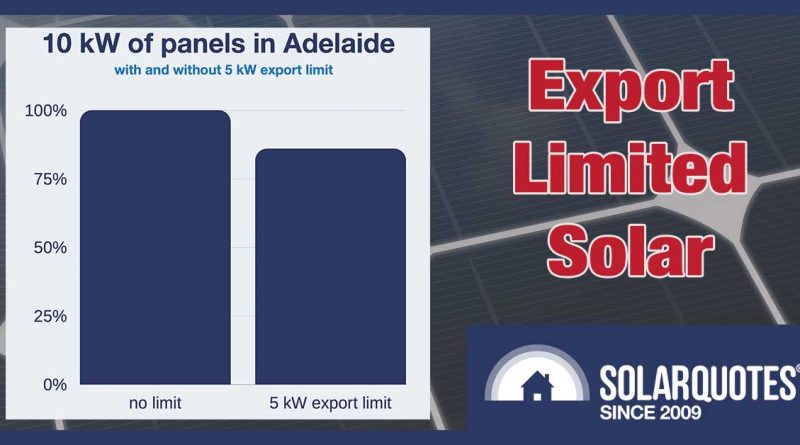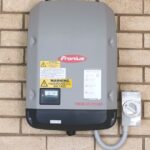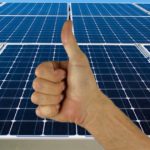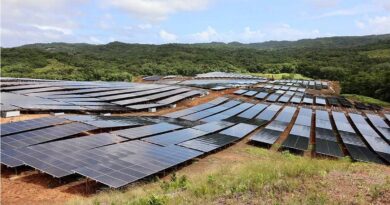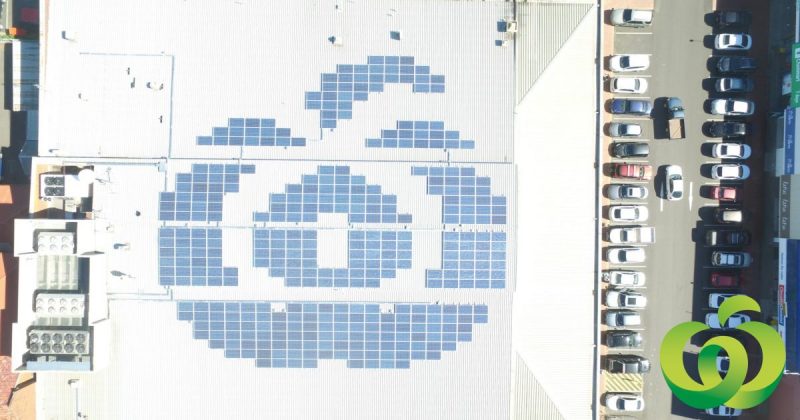Solar Export Limiting: Just How Much Energy Will You Lose?
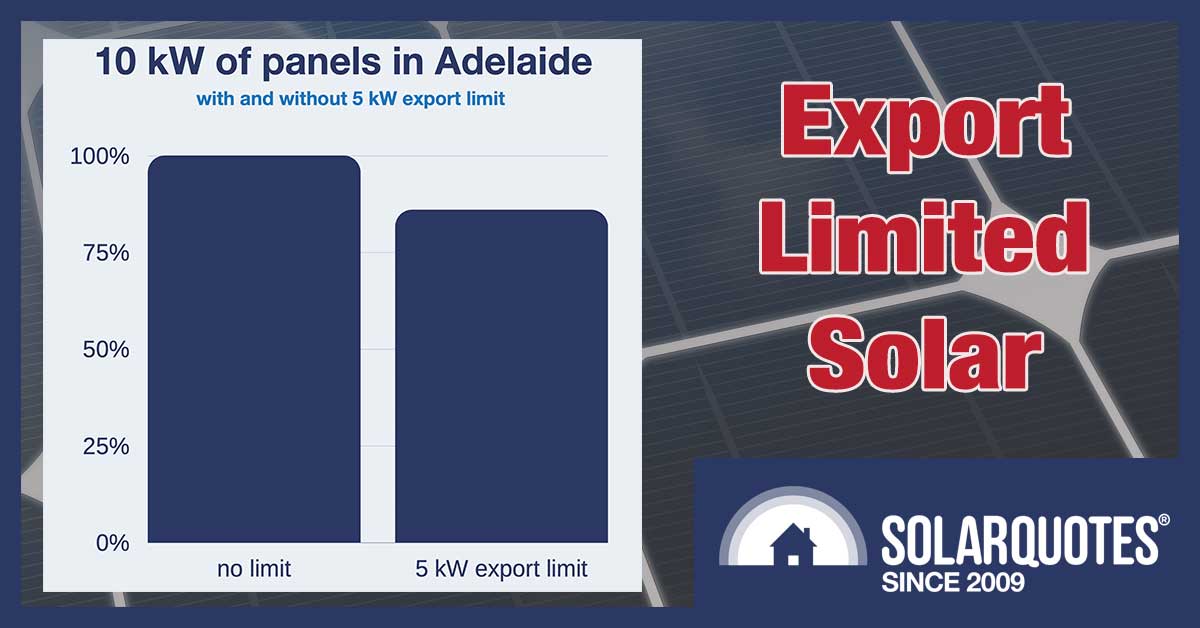
What are the losses from solar export limiting? — You’ll lose less energy generation than you think.
Export limited solar systems are becoming increasingly common.
Some new solar power system buyers are being told they can only proceed with an installation if the installer ‘export limits’ their system.
Export limiting is a polite way of saying ‘hobbled’. An export limited solar system will occasionally send less electricity into the grid than its inverter can supply. That can cause clean solar energy to go to waste.
That sounds awful, but the good news is: the amount lost is far less than most people expect.
If you were planning to install a 10 kilowatt solar system but were told the inverter had to be exported limited to 5 kilowatts — you might cry…
“Nooooooooooooo! Five is half of ten, I will lose half the solar generation!”
But that’s not how it works.
I have used PVWatts to investigate the likely output of export limited solar systems in every Australian capital. I found that — even in an absolute worst-case situation — the maximum amount of generation lost by a 10 kilowatt solar power system installation with a 5 kilowatt export limit is 14%.
In reality, the losses are likely to be considerably less. This because the worst-case situation involves…
- All solar panels facing the same direction.
- No electricity consumption by the household during the day.
While there are homes with large solar systems with all their panels facing the same way, there are damn few that don’t use any electricity at all during the day. Almost everyone has a refrigerator, and most homes have a freezer as well. On top of this, remaining losses can be reduced or even eliminated if a modest effort is made to switch electricity consumption to the middle of the day. For example, homeowners can put electric hot water systems, pool filters, and other appliances on timers so they’ll switch on when solar energy output is high.
In this article I will:
- Give a quick rundown of what solar export limiting is.
- Explain why the losses are usually small.
- Show graphs displaying losses in each Australian capital city in a worst-case situation.
- Finish off by saying, outside of extreme cases, the losses will be low. Then I’ll knock off early and have a liquid lunch.1
Solar Export Limiting Links
But if you’re anything like me, you’re not going to bother checking the links, so I’ll start by giving a quick explanation of what export limiting is.
Solar Export Limiting In A Nutshell
There is a limit to how much solar power local grids can accept without grid upgrades. Solutions are being developed and implemented, but there will be constraints until then. Solar export limiting is a useful way to reduce the problem because it can allow many homes to export most of their surplus solar energy. The alternative is a limited number of homes being allowed to export all their surplus solar power, with a big fat zero export limit for anyone installing solar later.
For moderate export limits, the amount of solar energy lost is small. While losing any clean generation is a shame, it’s better than the alternative where every new solar power system installation will be required to have a zero solar export limit because the grid can’t take any more.

My normal advice is to install as much solar as you can reasonably fit on your roof. But if you’re not absolutely flush with cash like I am…

Only a rich man can afford to burn through socks by wearing shoes like this…
I recommend installing as large a system as you can afford. If solar export limiting lets you install a larger system than you otherwise would be able to have, then I heartily recommend it — within reason.
Extreme Export Limiting
There are both good and bad reasons for export limiting a solar system:
- Good: Provided it is permitted at your location — it can allow you to install a larger system than you’d normally be able to.
- Bad: Due to local grid limitations, you can be required to export less to the grid than is normal in your area.
Using Export Limiting To Install A Large Solar System
If you are using export limiting to install a system larger than you’d otherwise be able to, for a typical installation it’s not possible to get too carried away. If, like many Australians, you face the following limits for new solar:
- The maximum amount of solar power that you can export to the grid: 5 kilowatts per phase.
- Maximum solar inverter capacity: 10 kilowatts per phase.
Then export limiting your solar power system installation will allow the capacity of your inverter to be up to 10 kilowatts per phase. This allows single-phase homes to have a large 10 kilowatt inverter, while 3 phase homes can have a massive 30 kilowatt inverter. For a normal installation2 solar panel capacity can be up to one-third larger than the inverter capacity, so the solar panel capacity can’t be more than 2.66 times greater than the export limit. While this large difference can result in losses, for most households, they shouldn’t be excessive.
Exports Limited To Less Than Usual
Unfortunately, an increasing number of Australians who want to install solar panels are told their exports will be limited3. The amount may be very small, or you could even be required to have a zero export limit. If you are faced with a very low or a zero export limit, you’ll have to decide if solar power is still worthwhile for you.
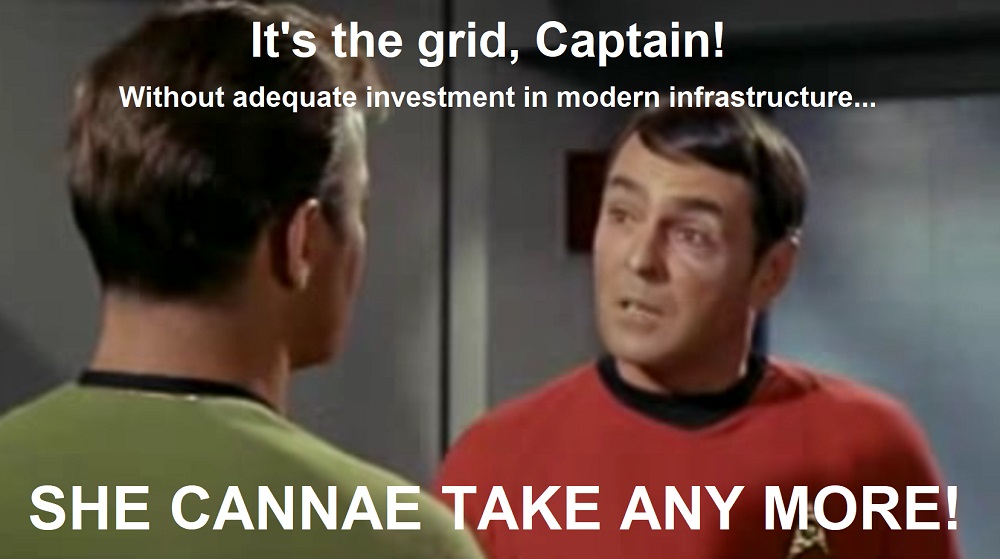
Even with a zero export limit, the good news is that it can still be financially worthwhile to install solar, as I explain in this article.4 A solar power system installation can pay for itself by only providing electricity to the home. In most cases, the system will have to be 6.6 kilowatts or less to keep the length of time required to pay for itself reasonable.
If a home can export any solar power, even if it is just one kilowatt, the financial situation improves considerably. But you may want to reconsider my usual advice of installing as much solar as you can.
Why Losses Are Minor
There are two main reasons why losses from solar export limiting are less than many expect:
- Most of the time, solar inverters operate well below their maximum capacity.
- Electricity consumption by the home reduces losses from export limiting.
Solar System Output Usually Below Maximum
For a solar inverter to provide its maximum output, the following two conditions usually have to be met:
- The solar panel capacity needs to be greater than the inverter capacity.5
- The sun needs to be close to directly over the panels.
It’s normal these days for solar systems to have a panel capacity up to one-third larger than the inverter capacity but — unless your name is Joshua and you blow a mean horn — the sun isn’t likely to stay still in the sky and let you maximize your solar output. Instead, the sun will spend most of the day either climbing up to the optimal position or climbing back down from it. For north-facing solar panels, this means they’ll only be able to provide their maximum output on a clear day around noon.
There are also plenty of other factors that contribute to solar systems normally operating below their potential maximum. These include…
- Clouds, haze, smoke, and smog.
- The low position of the winter sun in the sky — outside of the tropics.
- Heat: All else equal, each 10 degree increase in temperature reduces typical panels’ output by almost 4%.
- Solar panels often don’t face the optimal direction for maximum power output, which is normally north or close to it. They also usually aren’t at the ideal tilt angle.
- Dirt on panels.
- Etc.
So even if a solar power system with a 5 kilowatt export limit has 10 kilowatts of panels, most of the time those panels will be producing less than the 5 kilowatt export limit. At these times, it won’t be possible for solar energy to go to waste.

Household Consumption Comes First
Another major factor reducing losses is the consumption of solar power by the home itself. Only the surplus left over after household demand is met is available for export. So if a home with a 5 kilowatt solar export limit is consuming two kilowatts of power while the solar system produces 7 kilowatts of power, no generation will go to waste.
If no one is at home during the middle of the day, electricity consumption can be low, but most homes have at least a refrigerator running that will consume a portion of the solar energy produced. Even if no effort is made to shift consumption to the middle of the day, a normal home with a refrigerator and freezer will draw enough power to at least reduce losses.
Fortunately, it’s not difficult to shift electricity consumption to the middle of the day. Electric hot water systems and pool filters can be put on timers, as can many other appliances. This is a simple and effective way to reduce or eliminate losses. There are also more sophisticated approaches than using a timer, such as a solar hot water diverter or a relay.

Small Solar Systems & Extreme Export Limits
Self-consumption of solar energy can allow a household to have low losses from export limiting. This can be the case even if the export limit is very low, provided the solar system installation isn’t too large. If there are usually people at home during the day or an effort to shift electricity consumption to the daytime, then a 6.6 kilowatt solar power system can still have fairly low losses even if it has a one kilowatt export limit. But this will, of course, depend on how much electricity is consumed. If your home only averages 4 kilowatt-hours of consumption per day, there will still be plenty of losses in this situation.
I Used PVWatts
To work out the likely losses from solar export limiting in each Australian capital city, I used PVWatts. This handy American site gives estimates of solar output for locations around the world6. It lets you adjust a range of parameters and — within some limits — let me compare the output of systems with and without export limiting.7
One of the limits meant I could only get information for systems with a maximum panel capacity equal to twice their solar export limit. But most people using export limiting to install a large system probably won’t go far beyond this, so it’s not a huge drawback.
The PVWatts site may not be perfect, but I find it’s generally very accurate and I have a considerable amount of trust in the results it gives me. (If the results it gives turn out to be screwy I’m really going to look really stupid after saying that.)
It’s A Worst Case Scenario
There are three things to keep in mind when looking at losses from solar export limiting in the graphs below:
- The results are all based on a worst-case scenario.
- Every scenario is based on a worst-case situation, and finally…
- These scenarios — they don’t get worse than this.
The two main reasons why they are worst-case scenarios8 are:
- It is assumed the home consumes no electricity during the day, which is not realistic.
- All panels are assumed to face the same direction, which is normally not the case for larger solar systems.
While less important, there is another reason why they are worst-case scenarios:
- The results are for a new system installation, and no allowance is made for the slow deterioration in panel output that occurs over time.9 While this should only be around 0.5% a year for decent quality solar panels that have been properly installed, it’s enough to slowly reduce losses from export limiting as the years pass by.
Details Fed To PVWatts
It took me a long time to get all the information out of PVWatts for the capital cities. The process was so tedious it almost drove me to drink.
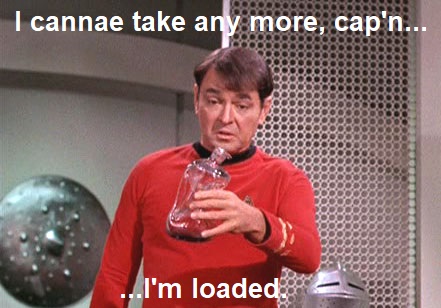
But in the end, I got it done, after making some decisions on…
- Solar panel direction – North
- Panel tilt – 20º
- Panel capacity and the solar export limit amount – 5, 6, 6.6, 7, 8, 9, 10 kW of panels, 5kW export limit.
Here are the results.
Adelaide
- Solar Export Limit: Normally 5 kilowatts per phase in South Australia.
- Inverter Capacity Limit: Normally 10 kilowatts per phase in South Australia.
Adelaide is the capital with the second-highest losses for export limited systems, mostly thanks to clear summer skies with occasional periods of mild temperatures as cold air moves in from the Southern Ocean. But even in this worst-case situation, an inverter export limited to 5 kilowatts with 10 kilowatts of panels will only lose 14% of total generation. This is in comparison to a 10 kilowatt inverter with 10 kilowatts of solar panels and no export limit.
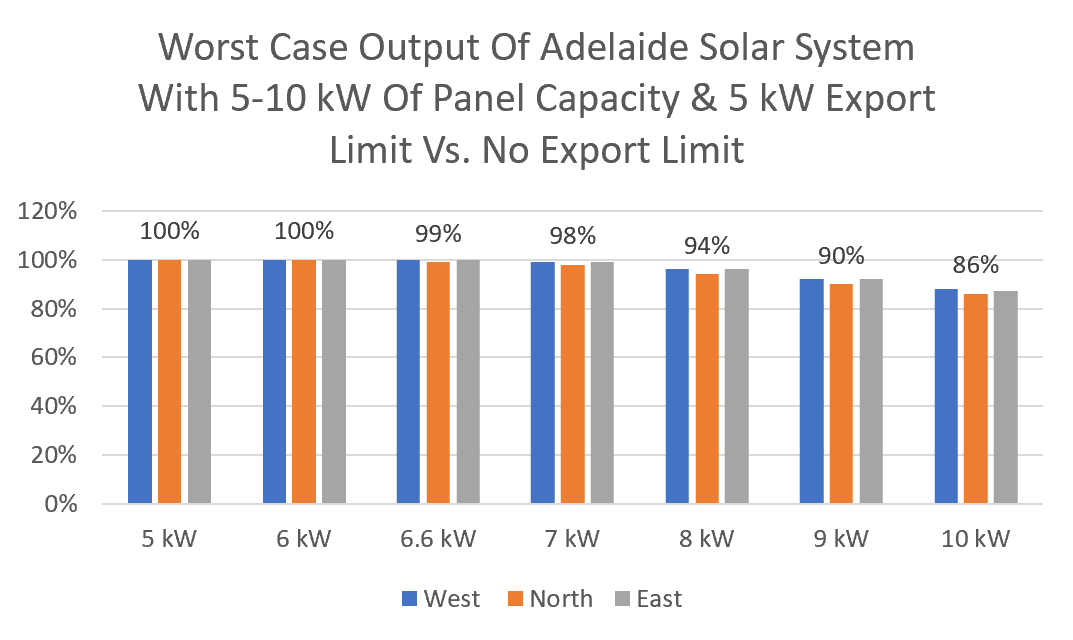
Brisbane
- Solar Export Limit: Normally 5 kilowatts per phase in Queensland.
- Inverter Capacity Limit: Normally 10 kilowatts per phase in Queensland.
While closer to the equator than Adelaide, losses are lower in Brisbane. This is because Brizzy summers tend to be cloudy with clearer skies in winter, making for more even output through the year. There is no appreciable loss from having an export limit of 5 kilowatts until solar panel capacity reaches 8 kilowatts or more.
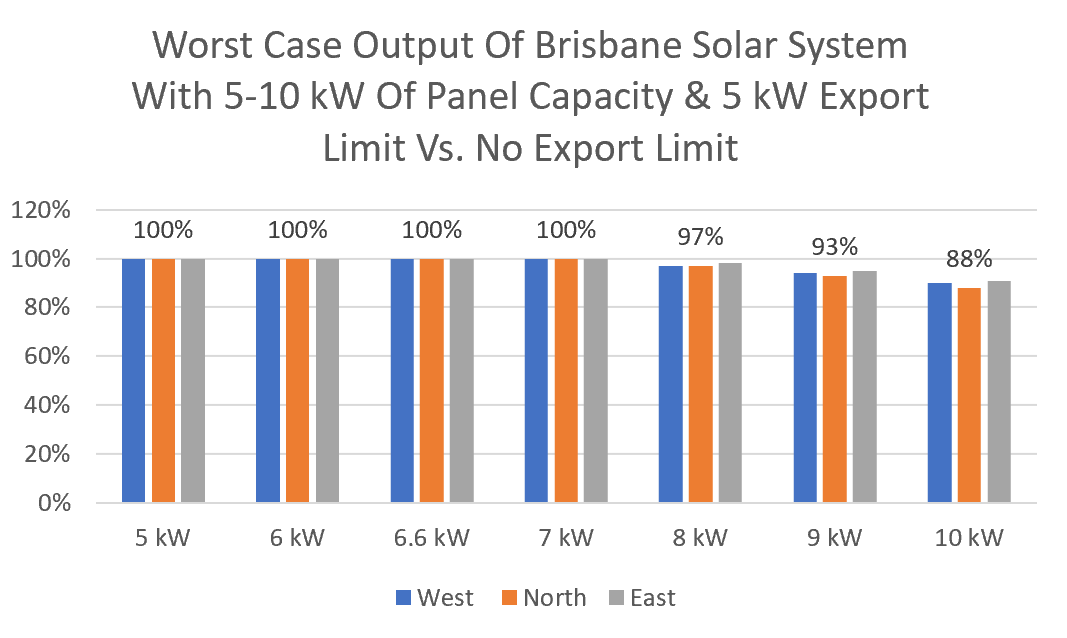
Canberra
- Solar Export Limit: Normally 5 kilowatts per phase in the ACT.
- Inverter Capacity Limit: Normally 10 kilowatts per phase in the ACT.
Canberra, the nation’s capital, has the highest losses. This is thanks to clear summer skies. Also, cool clear days in spring and autumn may contribute thanks to reduced losses from heat. But while slightly worse than Adelaide, even in this worst-case situation, only 14% of total generation is lost with 10 kilowatts of panels and a 5 kilowatt export limit. If the solar panels were all facing east or west, the losses would be only 10%.
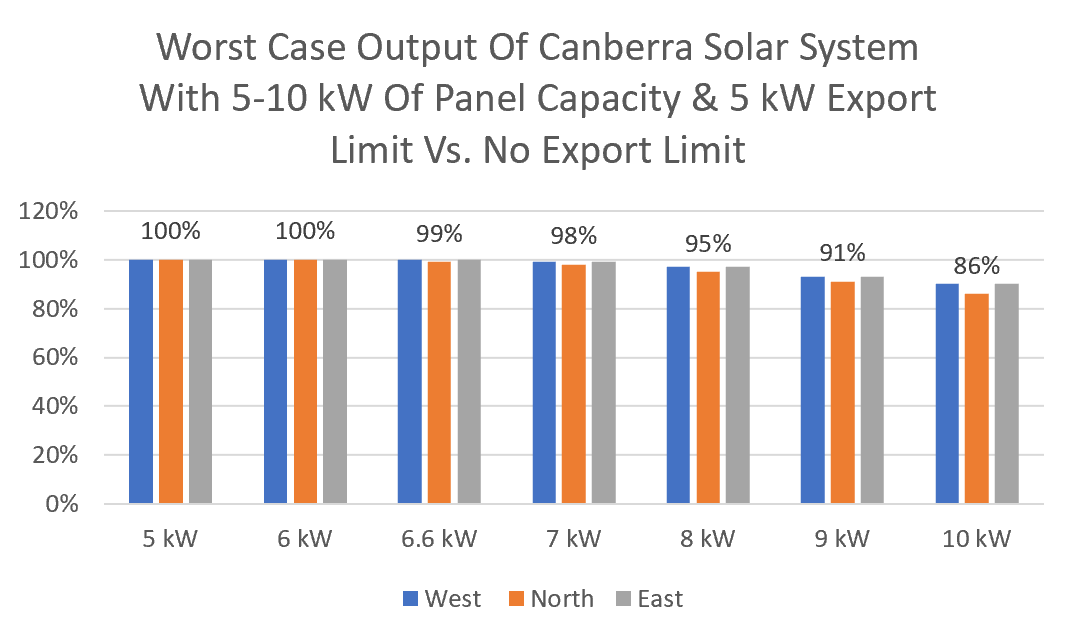
Many inland locations will have results similar to Canberra, though losses will increase modestly with diminishing average cloud cover.
Darwin
- Solar Export Limit: Normally 5 kilowatt export limit for single-phase homes and 7 kilowatt total export limit for three-phase homes around Darwin, Alice Springs, Katherine and Tennant Creek.
- Inverter Capacity Limit: Same as for the export limit. This means export limiting can’t be used to install a larger system. The graph below ignores this fact so you can see what results export limiting would have.
Darwin stands out as the capital with the lowest losses. This is mainly due to the big wet causing plenty of cloud cover in summer, while the big dry brings winter clear skies. Besides, Darwin is so close to the equator north-facing panels at a 20 degree tilt are sub-optimal for summer generation. Darwin is also unique because it’s the only capital where east and west-facing solar panels have greater losses than north-facing ones. This is presumably due to Darwin’s weird weather combined with being nearly as far north as you can get and still be in Australia.
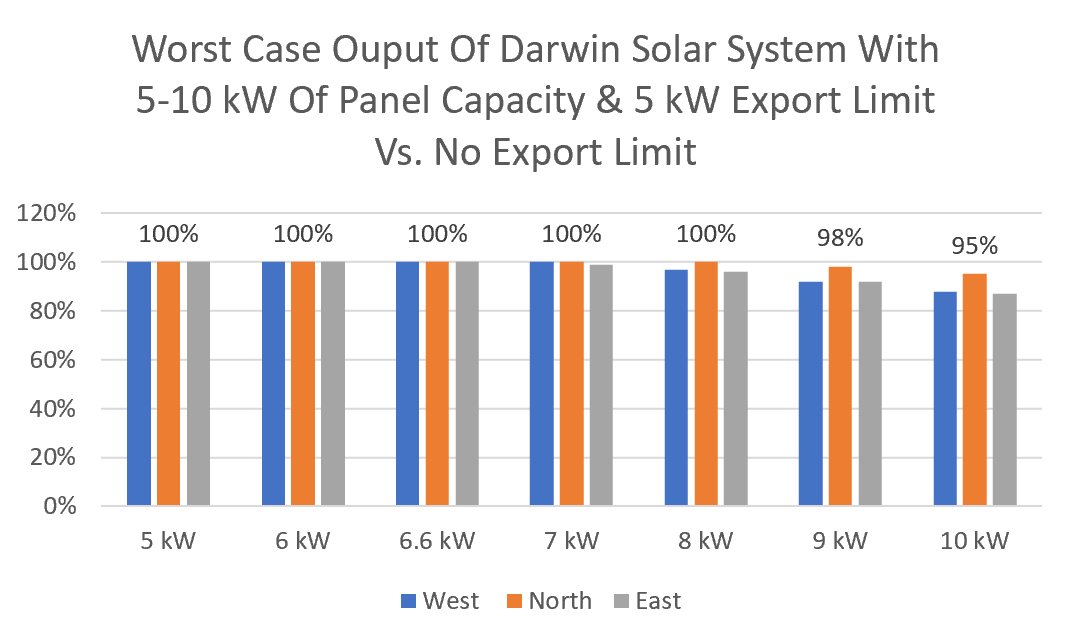
Hobart
- Solar Export Limit: Normally 10 kilowatts per phase in Tasmania.
- Inverter Capacity Limit: Normally 10 kilowatts per phase in Tasmania. This means export limiting is not required to install a larger system. The graph below shows the worst-case losses if a 5 kilowatt export limit per phase was introduced — which may happen in the future.
Hobart has the second-lowest losses thanks to being the cloudiest capital and about as far south as it’s possible to get without being in Antarctica. The high cloud cover and southerly location are slightly countered because it can get damn cold by mainland standards.
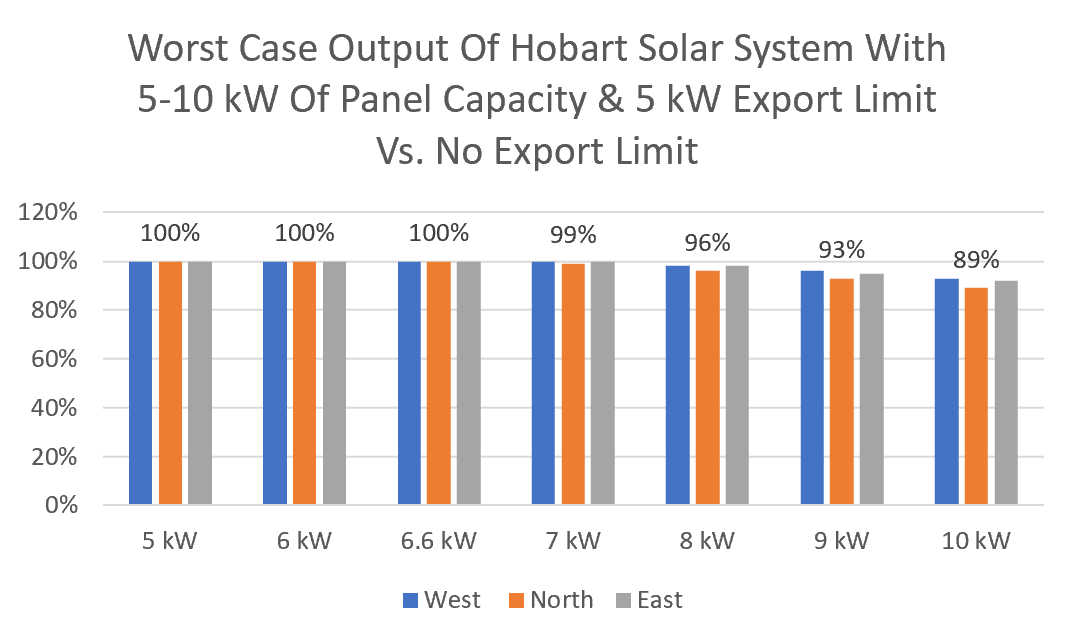
Melbourne
- Solar Export Limit: Depends on location — Normally either 5 or 10 kilowatts per phase. Many new installations in Melbourne are now required to be export limited below the normal 5 or 10 kilowatt amount.
- Inverter Capacity Limit: Depends on location — Normally 5 or 10 kilowatts per phase. Whether export limiting is normally required to install a larger system will depend on location.
Thanks to Melbourne weather only being a modest improvement over Hobart, losses are not very high.
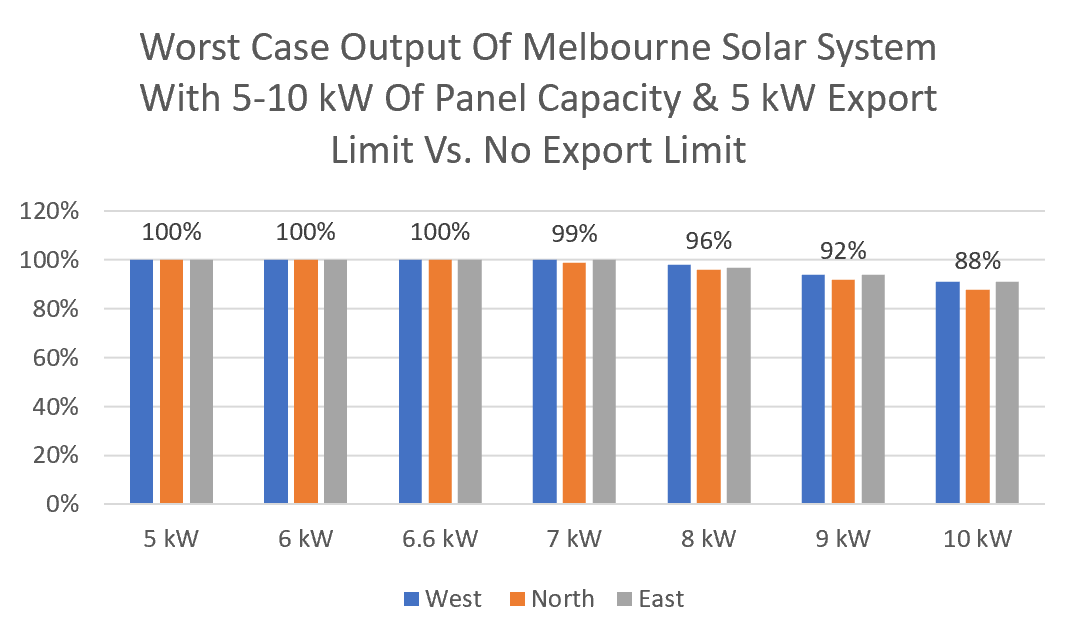
Perth
- Solar Export Limit: 5 kilowatts for single-phase. Potentially equal to inverter capacity for 3 phase but (low) solar feed-in tariff only available to residences with 5 kilowatts of inverter capacity or less.
- Inverter Capacity Limit: 5 kilowatts for single phase. Up to 30 kilowatts for three-phase but 8-22 kilowatts is the usual range allowed.
I expected Perth losses to be similar to those in Adelaide, but the WA capital does slightly better. This is likely due to the higher temperature resulting in fewer cool but clear days.
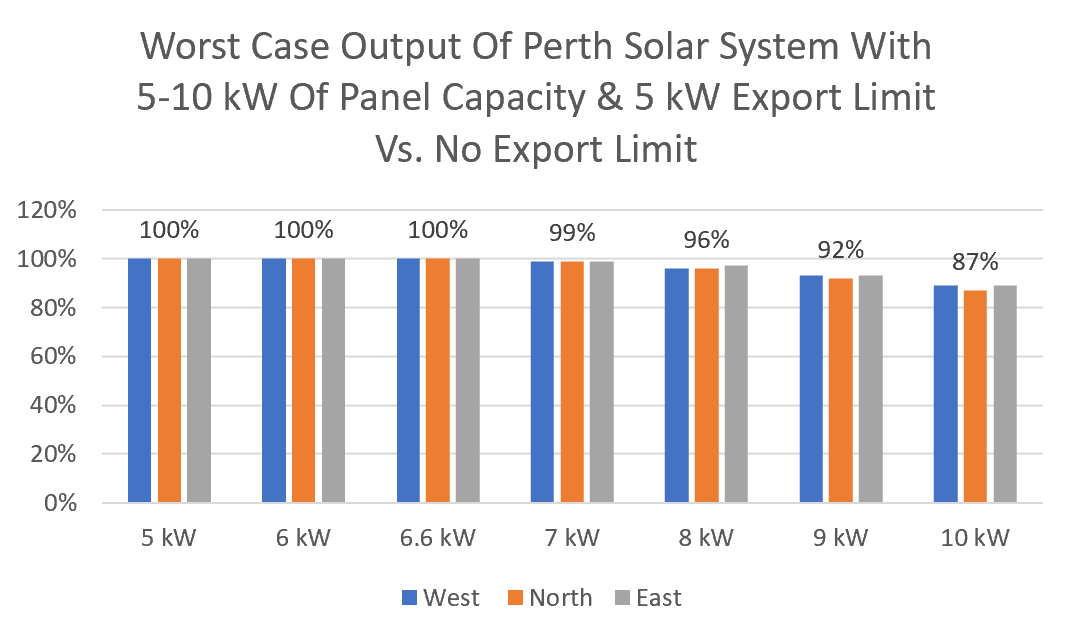
Sydney
- Solar Export Limit: Normally 5 kilowatts per phase for most Sydney homes but normally 10 kilowatts per phase in the East Sydney Ausgrid area. This means export limiting is normally not required for a large system in east Sydney.
- Inverter Capacity Limit: Normally 10 kilowatts per phase.
Sydney, Australia’s most populous city, is pretty much in the middle in terms of losses for the sub-tropical capitals. Even in this worst-case situation, losses aren’t particularly high and come in at 13% for 10 kilowatts of solar panels with an export limit of 5 kilowatts. In real life, they’re likely to be considerably less.
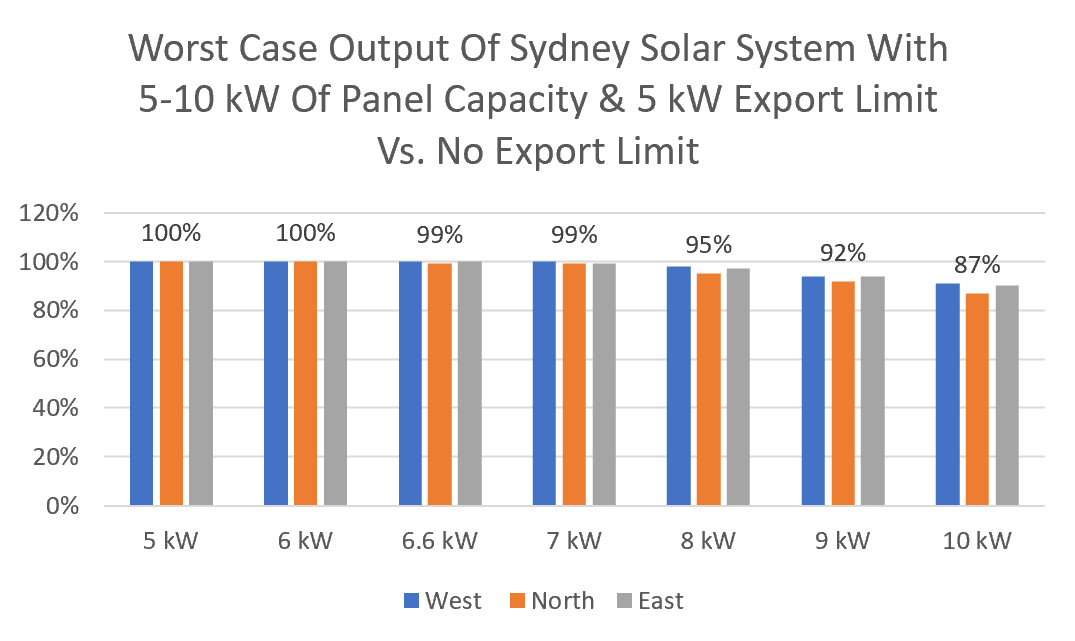
Losses Are Low
As you can see, even in an absolute worst-case situation where…
- All solar panels face in one direction.
- The system is new.
- The household consumes no power during the day.
The losses from having panel capacity double the solar export limit are no more than 14% in any capital.
This is not a large amount, and because the results are for an absolute worst-case situation, losses should be considerably less under real-life conditions. Having panels face in two or more directions and minimal daytime electricity use is likely to eliminate losses or reduce them to a trivial amount. It also takes little effort to shift electricity consumption to the middle of the day. This can allow a home with a panel capacity well over twice the export limit to experience little or no generation loss. If you own a pool, you’re probably set. You can also use electric hot water systems and other devices to reduce or eliminate losses.
Generally speaking, the larger a solar power system installation is, the lower it will cost per kilowatt of panel capacity. So even if all your panels face one direction and — for some strange reason — you lack the motivation to shift consumption to the middle of the day, it can still make perfect financial sense to install a larger, export limited solar system. Even if you are not certain a larger system will make you financially better off, you are helping future-proof your home for when battery systems become cost-effective or you get an electric car.
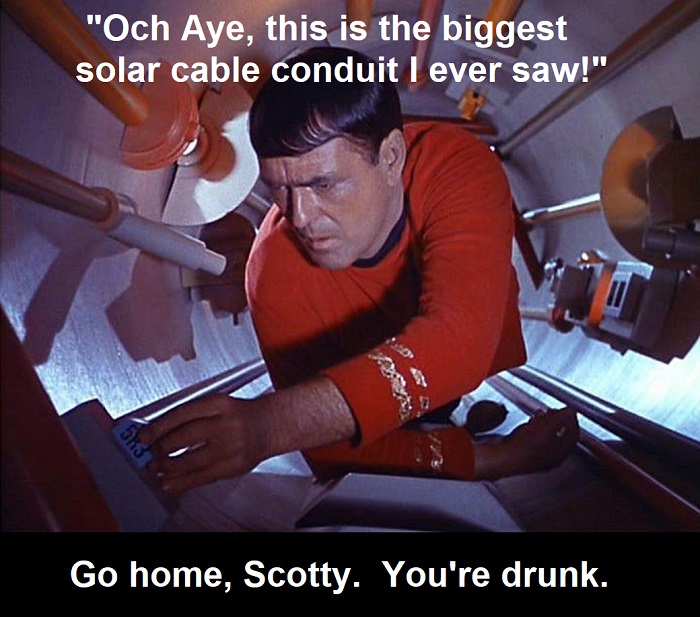
Footnotes
- Pepsi and soup. Or if my funds are inadequate — just Pepsi soup. ↩
- Normal in this case is an on-grid installation, uses STCs, and a battery isn’t installed at the same time. ↩
- In some places, being export limited is the new normal. ↩
- While only written a year ago, the article’s already a little dated as the cost of decent quality solar has fallen since then. ↩
- Solar panels can provide more power than their rating, especially when new, but this rarely happens and — in this situation — it isn’t worth worrying about. ↩
- It’s such a relief to be able to mention the PVWatts site is American without having to worry the Trump Administration will realize they’re doing something useful and put a stop to it. ↩
- If you go to “Advanced Parameters” in PVWatts you can change the “DC to AC size ratio” from as low as 0.4 to as high as 2. Setting it to 1 will give the results for a system where the inverter has the same capacity as the solar panels. Setting it to 2 will give results for a system where the inverter capacity is half the panel capacity. I can use this to estimate the output of an export limited system for a home that consumes no electricity during the day. While it’s not the same thing, the results will be very close. ↩
- Besides the fact that PVWatts was only able to provide me with information for worst-case situations. ↩
- Allowance is made for Light Induced Degradation, or LID, that occurs in panels during the first day or two after installation. ↩
Original Source: https://www.solarquotes.com.au/blog/solar-export-limiting-losses/

